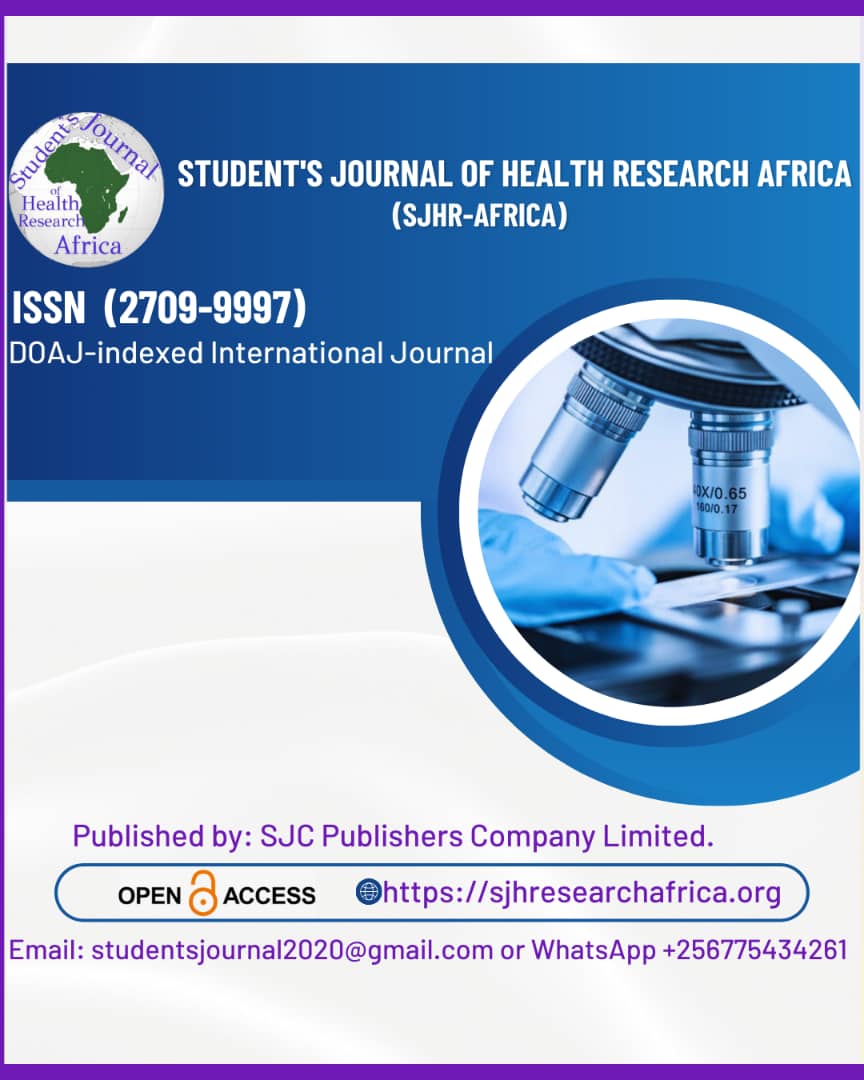Antibacterial profiles of bacterial isolates from maternity ward hospital beds at Bubulo health centre IV, A cross- sectional study.
DOI:
https://doi.org/10.51168/sjhrafrica.v6i9.2099Keywords:
Antibacterial profile, Bacterial isolate, Hospital bed surface, Maternity ward, Health Centre IV, Disk diffusion method, Zone of inhibition, Gram-positive bacteriaAbstract
Background:
Healthcare-associated infections (HAIs) remain a major challenge in maternity wards, particularly in low-resource settings like Uganda. This study investigated the antibacterial profiles of bacterial isolates from maternity ward bed surfaces at Bubulo Health Centre IV, Manafwa District, to address knowledge gaps and inform infection control practices.
Methodology:
A cross-sectional, laboratory-based analytical study was conducted over three months, during which 60 swab samples were collected from high-touch points on maternity beds, including mattress covers, bed rails, and headboards. Samples were cultured on selective media, and bacterial isolates were identified through Gram staining and biochemical tests. Antibacterial susceptibility testing was performed using the Kirby-Bauer disk diffusion method in accordance with CLSI guidelines.
Results:
The study identified five bacterial species: Staphylococcus aureus (33.3%), Escherichia coli (20%), Enterococcus spp. (16.7%), Klebsiella pneumoniae (15%), and Proteus spp. (15%). Gram-positive and Gram-negative bacteria were equally represented (50% each). Antibacterial susceptibility testing revealed that Gram-positive isolates were highly sensitive to Vancomycin (100%) and Gentamicin (80–90%), with 25% of S. aureus isolates resistant to Oxacillin, suggesting possible MRSA strains. Gram-negative isolates showed high sensitivity to Ciprofloxacin (88–83%) and Ceftriaxone (77–75%), but moderate to high resistance to Ampicillin (33–66%) and Co-trimoxazole (33%). These findings indicate the presence of multidrug-resistant organisms on maternity bed surfaces, highlighting the risk of nosocomial infections.
Conclusion:
Maternity bed surfaces at Bubulo Health Centre IV are contaminated with clinically significant bacteria, including multidrug-resistant strains. The study underscores the urgent need for stringent IPC practices, routine environmental surveillance, rational antibiotic use, and targeted cleaning and disinfection strategies to safeguard maternal and neonatal health.
Recommendation:
Strengthen national infection prevention guidelines, ensure strict cleaning and disinfecting practices in health facilities, provide regular staff training and supplies, and promote public awareness on personal and environmental hygiene
References
Kasozi, K., Namuyonga, J., & Mukisa, J. (2020). Environmental prevalence and antimicrobial resistance patterns of Enterococcus spp. in Ugandan healthcare facilities. African Journal of Microbiology Research, 14(3), 111–121. https://doi.org/10.5897/ajmr2020.9123.
Kyamulabi, M., Izudi, J., Mujugira, A., & Okoboi, S. (2025). High prevalence of multidrug-resistant bacteria on patient medical file surfaces at five critical care units in Kampala, Uganda: An explanatory sequential mixed-methods study. Infection Control & Hospital Epidemiology, 46(5), 1–3. https://doi.org/10.1017/ice.2025.26
Makwela, A. B., Grootboom, W. M., Abraham, V., Witika, B., Godman, B., & Skosana, P. P. (2023). Antimicrobial Management of Skin and Soft Tissue Infections among Surgical Wards in South Africa: Findings and Implications. Antibiotics, 12(2), Article 2. https://doi.org/10.3390/antibiotics12020275
Mayanja, M. N., Kigozi, S. P., Aisu, S., Asiimwe, B. B., & Bazira, J. (2023). Multidrug-resistant Gram-negative bacteria associated with mothers, newborns, and their hospital environment in a tertiary hospital in Uganda. PLOS Global Public Health, 3(2), e0001476. https://doi.org/10.1371/journal.pgph.0001476
Mayito, J., Kibombo, D., Olaro, C., Nabadda, S., Guma, C., Nabukenya, I., ... & Kajumbula, H. (2024). Characterization of antibiotic resistance in select tertiary hospitals in Uganda: An evaluation of 2020 to 2023 routine surveillance data. Tropical Medicine and Infectious Disease, 9(4), 77. https://doi.org/10.3390/tropicalmed9040077
Nakibuuka, D., Ojara, M., & Ochola, R. (2023). Antimicrobial resistance patterns of Gram-negative bacterial isolates from high-touch surfaces in Ugandan healthcare facilities. Infection Prevention in Practice, 5(4), 100332. https://doi.org/10.1016/j.infpip.2023.100332
Namanya, P., Lutaaya, R., & Musoke, D. (2022). Hospital-acquired infections in Uganda: Current trends and the impact of antimicrobial resistance on clinical outcomes. Journal of Hospital Infection, 126, 67–76. https://doi.org/10.1016/j.jhin.2022.01.015
Obakiro, S. B., Kiyimba, K., Paasi, G., Napyo, A., Anthierens, S., Waako, P., ... & Kostyanev, T. (2021). Prevalence of antibiotic-resistant bacteria among patients in two tertiary hospitals in Eastern Uganda. Journal of Global Antimicrobial Resistance, 25, 82–86. https://doi.org/10.1016/j.jgar.2021.02.021
Sserwadda, B., Musisi, N., Wanyenze, R. K., et al. (2018). Bacterial contamination of maternity and neonatal equipment in a district hospital in Uganda: Implications for infection prevention. BMC Pregnancy and Childbirth, 18, 281. https://doi.org/10.1186/s12884-018-1905-x
Tumwesigye, P., Ssentongo, R., & Kizito, J. (2021). Antibiotic resistance in hospital-associated pathogens: A study from Eastern Uganda. Antimicrobial Resistance & Infection Control, 10, 54. https://doi.org/10.1186/s13756-021-00937-5
Twinamasiko, N., Byamugisha, J., Harrison, R., Semulimi, A. W., Mutebi Kasoma, R., Mukisa, J., ... & Banura, C. (2023). Bacterial contamination of clinical coats of medical doctors: A cross-sectional study in Mulago National Referral Hospital in Uganda. Infectious Diseases and Tropical Medicine, 9, e1203. https://doi.org/10.1016/j.idtm.2023.e1203
World Health Organization (WHO). (2020). Guidelines on core components of infection prevention and control programmes at the national and acute health care facility level. https://www.who.int/publications/i/item/9789241516945
Otter, J. A., Yezli, S., Salkeld, J. A. G., & French, G. L. (2013). Evidence that contaminated surfaces contribute to the transmission of hospital pathogens and an overview of strategies to address contaminated surfaces in hospital settings. American Journal of Infection Control, 41(5), S6–S11. https://doi.org/10.1016/j.ajic.2012.12.004
Downloads
Published
How to Cite
Issue
Section
License
Copyright (c) 2025 Daniel Manowa, Mr. Habert Mabonga, Mr. James Kasozi

This work is licensed under a Creative Commons Attribution-NonCommercial-NoDerivatives 4.0 International License.





















